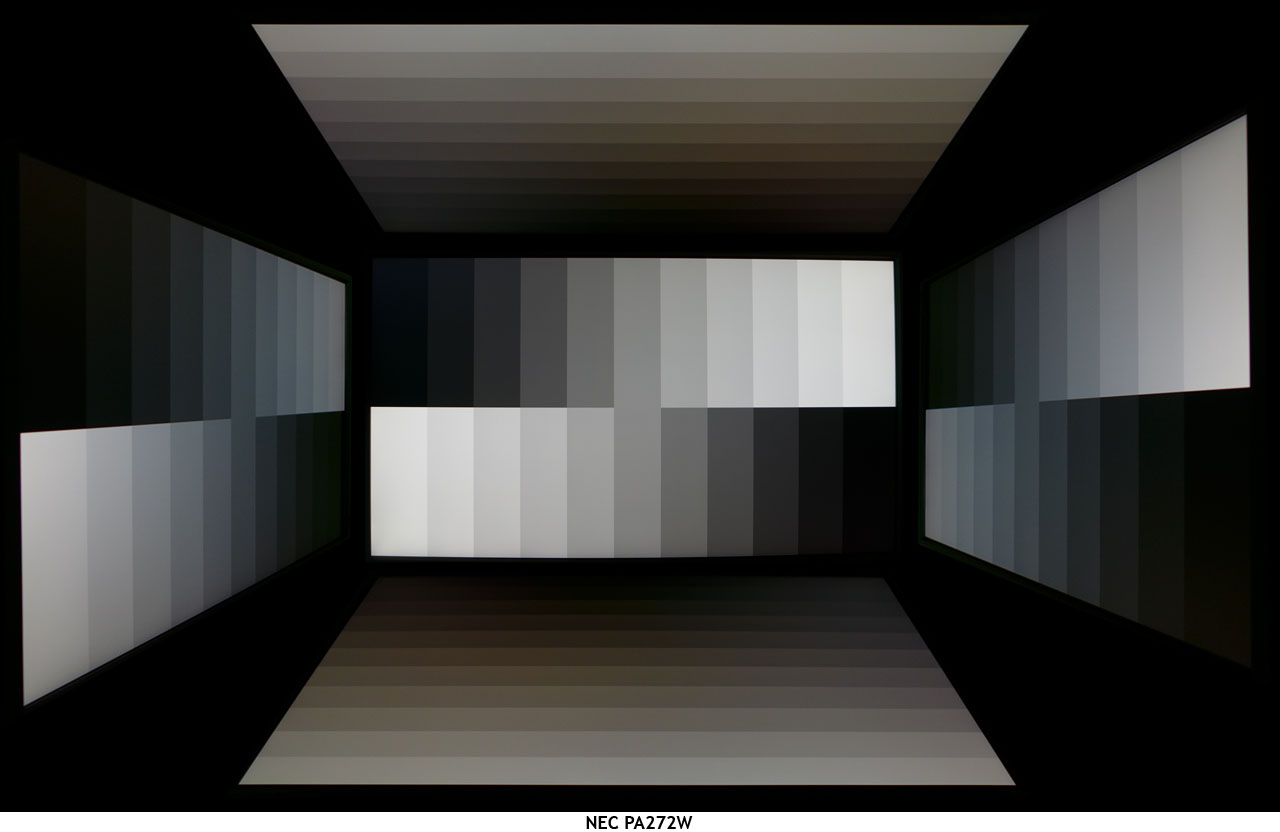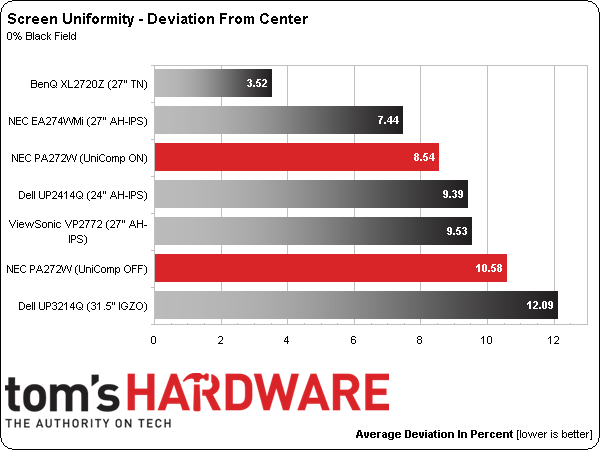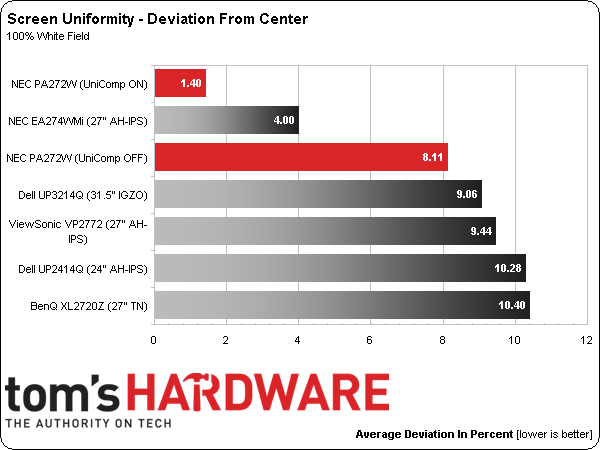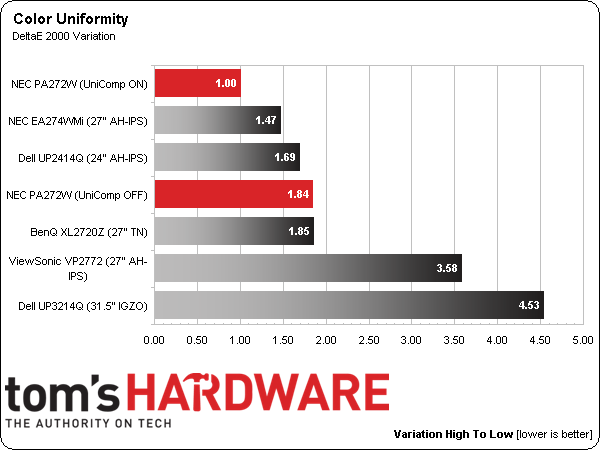NEC PA272W 27-Inch Monitor Review: Accuracy And Flexibility
We’ve reviewed a lot of professional-class monitors, NEC's PA272W may be the most accurate and capable one ever to hit the Tom's Hardware lab. At almost $1300, it’s expensive for a 27-inch QHD screen. But there are features here you won’t find elsewhere.
Results: Viewing Angles And Uniformity
The more monitors we test, the more we can see that off-axis viewing performance is dependent not only on pixel structure (IPS, PLS, TN, etc.) but the backlight technology as well. And we can see that the anti-glare layer makes a difference too.
Remember back to ViewSonic's VP2772? If you think the PA272W’s off-axis pictures look a lot like that screen, we won't be surprised. After all, they both employ the same LG panel.
You can see a slight red shift in the top and bottom shots, and almost no tint in the side-to-side views. Moreover, there’s little loss of detail. Of course, for critical work where you plan on sitting front and center anyway, consider a hood for the best possible image quality.
Screen Uniformity: Luminance
To measure screen uniformity, zero and 100-percent full-field patterns are used, and nine points are sampled. First, we establish a baseline measurement at the center of each screen. Then the surrounding eight points are measured. Their values get expressed as a percentage of the baseline, either above or below. This number gets averaged. It is important to remember that we only test the review sample each vendor sends us. Other examples of the same monitor can measure differently.
Our results reflect both the On and Off settings of the uniformity compensation. There are five levels ranging from strong (5) to weak (1). We used 5 and Off in our tests. You’ve already seen how level 5 affects contrast. Now it’s time to see if that reduction is worth the improved screen uniformity.
The black field measurement with compensation off is about average among the monitors we’ve tested. We couldn’t see any hotspots on our press sample, but the C6 meter tells us that the upper-right and lower-left corners are a tiny bit brighter. Turning the compensation on yields a two-percent improvement.
Here’s the white field measurement:
Get Tom's Hardware's best news and in-depth reviews, straight to your inbox.
Screen uniformity is just shy of seven percent in the full-white field pattern. Again, you wouldn't be able to see that with a naked eye. Our meter says the center portion of the screen is brightest and the upper-left zone is a bit dimmer. I stand by my preference of leaving the compensation off, and enjoying better contrast and black levels.
Screen Uniformity: Color
To measure color uniformity, we display an 80-percent white field and measure the Delta E error of the same nine points. Then we subtract the lowest value from the highest, giving us a result. A smaller number means a display is more uniform. Any value below three translates to a variation that is invisible to the naked eye.
The compensation feature helps a little with color uniformity as well. Both results are well below the threshold of visibility, however. Regardless of signal level, the PA272W renders a perfectly smooth-toned image over the entire screen. The performance is excellent.
Current page: Results: Viewing Angles And Uniformity
Prev Page Results: Color Gamut And Performance Next Page Results: Pixel Response And Input Lag
Christian Eberle is a Contributing Editor for Tom's Hardware US. He's a veteran reviewer of A/V equipment, specializing in monitors. Christian began his obsession with tech when he built his first PC in 1991, a 286 running DOS 3.0 at a blazing 12MHz. In 2006, he undertook training from the Imaging Science Foundation in video calibration and testing and thus started a passion for precise imaging that persists to this day. He is also a professional musician with a degree from the New England Conservatory as a classical bassoonist which he used to good effect as a performer with the West Point Army Band from 1987 to 2013. He enjoys watching movies and listening to high-end audio in his custom-built home theater and can be seen riding trails near his home on a race-ready ICE VTX recumbent trike. Christian enjoys the endless summer in Florida where he lives with his wife and Chihuahua and plays with orchestras around the state.
-
SuckRaven Every time Tom's Hardware reviews monitors, I keep posting in the comments that they should review NEC and EIZO for accuracy in comparison to the usual suspects. Finally my prayers have been answered. (Not that there are not other places that have not already done a good job of including reviews of high-end monitors with color accuracy, and uniformity as the main focus), but Tom's has always been a preferred resource. Anyways, you guys should do a shootout with the top flagships from HP, Dell, NEC and and EIZO, perhaps the CG277). Nice review.Reply -
Pikker I've recently purchased this monitor with calibration tools and hood for a discounted price, needless to say it looks incredible, putting to shame an older 27" IPS display that I had.Reply
Regarding the NEC 272 vs. Eizo 277, I think they are more same than different... the Eizo has an integrated calibrator, 16-bit LUT, bigger color space, and a bunch of other tweaks that should objectively make it a better display, but not ~$1000 better IMO. If you have that kinda money to burn, get two PA272W's instead. -
ubercake Good review.Reply
I think everyone should notice the low-cost IPS monitors offer sub-par contrast. Who cares about color accuracy if you can't see the in-betweens? Aren't the shades/hues just as important? This is something people don't realize when they pick up that $400 IPS display. Heck, contrast is better on the BenQ TN display than on the less expensive IPS displays in the review. Color without good contrast is a waste. Contrast is what you compromise at the lower end of the IPS monitor scale.
You have to spend money to get a quality IPS monitor. It's good to see that you can get this kind of performance at a lower price point now.
This NEC monitor is definitely impressive. It has great color accuracy AND contrast. Great for photography and graphic arts/design applications. This is a pro monitor and why you spend money on an IPS monitor. -
ceberle Reply13488868 said:Every time Tom's Hardware reviews monitors, I keep posting in the comments that they should review NEC and EIZO for accuracy in comparison to the usual suspects. Finally my prayers have been answered. (Not that there are not other places that have not already done a good job of including reviews of high-end monitors with color accuracy, and uniformity as the main focus), but Tom's has always been a preferred resource. Anyways, you guys should do a shootout with the top flagships from HP, Dell, NEC and and EIZO, perhaps the CG277). Nice review.
Look for a review of the HP Z27x in a few weeks. It's in our lab now.
-Christian- -
PapaCrazy Bought one of these and ended up with a display that had several dead pixels and a couple hot pixels. Exchanged it, got a display with even more deal pixels, I stopped counting in the teens. For $1400, seems offensive. Dell was offering a zero dead pixel guarantee for half the price with the u2711. Calibrated, it seems to do quite well in color accuracy, I never get complaints after file deliveries, but the Dell is made like a piece of shit. Has a major heating problem which effects the top (where the heat collects) of the display's color output after intensive usage. I'm sick of this over-inflated display market. They are either under-engineered or overpriced.Reply -
Pikker ReplyBought one of these and ended up with a display that had several dead pixels and a couple hot pixels. Exchanged it, got a display with even more deal pixels, I stopped counting in the teens. For $1400, seems offensive.
That's some bad luck... I got mine from B&H and the display was perfect out of the box. Otherwise, the thing is built like a tank with an all-metal frame under the plastic outer shell, and it doesn't flex no matter what, if anything, I'd say it's over-engineered. -
PapaCrazy Reply13514585 said:Bought one of these and ended up with a display that had several dead pixels and a couple hot pixels. Exchanged it, got a display with even more deal pixels, I stopped counting in the teens. For $1400, seems offensive.
That's some bad luck... I got mine from B&H and the display was perfect out of the box. Otherwise, the thing is built like a tank with an all-metal frame under the plastic outer shell, and it doesn't flex no matter what, if anything, I'd say it's over-engineered.
Got mine from B&H too. NEC released an upgraded model w/ improved colorimeter shortly after my purchase. It could very well have been an accumulation of old stock, the backwash of sorts, that I drank from. When studying up, I found the only way to get a guarantee of zero dead pixels on NEC displays, you need to pony up for the ultra-expensive medical grade displays. It is well made though, I thought the portrait mode was a great feature and the stand was far more solid than the Dell's. Ran cooler as well. (thermally I mean)



